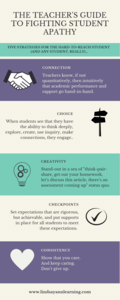Do you have an imaginary teacher persona, an avatar of sorts programmed into your brain? I do.
I like to think that I’m a blend of Mary Poppins, Katniss Everdeen, and Hermione Granger. A little bit of sweet, sass, and smarts.
I also like to think that I’m a good teacher. But every year, life gives me a hard-to-reach student (or two or three). You know the type…the tired, the smirking, the do-nothing students. Those who try to hide use of Airpods to tune you out in hopes that you won’t notice…student apathy at its finest.
For many years, I let these students get to me, throw me off my game. I’ve learned, though, that you can’t let them steal your sparkle…In fact, that’s the worst thing you can do.
Here is the BEST thing you can do – implement these five ways to combat student apathy, all conveniently starting with the letter “C.”
Connection fights student apathy
We, as humans, desire to be known, to be understood, to feel like someone “gets” us. Education begins with connection. According to long-time educator, Doctor Trenton Hanson, in his article for Leadership, “Evidence suggests that the empathy and caring of even one adult in the life of a child can prevent future negative consequence for that child.” That’s huge… all it takes is ONE.
Teachers know, if not quantitatively, then intuitively that academic performance and rapport go hand-in-hand. We begin the year by establishing norms, create opportunities for students to feel “safe” and use their voice in classroom conversation. We play ice-breaker games and plan team-building activities. We survey students about their interests and work those interests into class whenever possible. We greet students at the door, have classroom traditions, and the list goes on. All of this because we know that, if students have a connection to teachers as a human, not just as a teacher, they are likely to want to perform better.
This is not to say that it is always easy. The apathetic students are our hardest audience to reach, right? They’re the “indifferent audience” that first needs to be made to feel something before they can be won over. To do this, we have to go in with caring and our “game face,” you know the one that doesn’t get flustered, that keeps on keepin’ on no matter what.
- Some students need to see that we won’t give up on them like other teachers have.
- Some students need to see that they can achieve small wins, that they can do it. Some students need to see that we care about them, no strings attached, no grade attached, just because.
- And some students, despite our best efforts, will not be ready to connect, but we won’t give up on them.
Choice fights student apathy
Student choice and connection go hand-in-hand in fighting student apathy. When students see that they have the ability to think deeply, explore, create, use inquiry, make connections, the relationship with the teacher is strengthened. When students feel like they are “in a box,” always wondering what the “right” answer is, and what the “teacher wants,” the relationship is weakened. If you’re looking for ways to make your classroom more student-centered, particularly with student-led discussion, be sure to check out this blog post.
I think the key here is in the unspoken messages we send students. If my classroom promotes inquiry and values student choice and voice as a part of the learning process, I’m sending the message that I value students as partners in learning, that I don’t “have all of the answers,” but will guide them as they find answers for themselves. I’m sending the message that students are capable of asking and answering tough questions. On the flip-side, if my classroom is rigid, black-and-white, there is a lack of trust in my students as learners.
Sometimes, this trust has to be earned. I also understand that some learners are not yet ready for complete autonomy. If this is your situation, I would encourage you to think about ways to build in choice with boundaries. Maybe you want to give students options for their focus in an essay, or choice between a couple of different final products (that both demonstrate the same skills). Be persistent. Like anything, independence and inquiry are skills that we need to foster in students. Maybe you’ll start the year with a lot of structure as students learn expectations and then gradually release to independence as the year goes on.
Creativity fights student apathy
Do you remember a project from your school days that REALLY allowed you to be creative? Even a lesson or activity will suffice… I sometimes think of how the high school students I teach have six or seven other classes each day. How am I standing out in a sea of think-pair-share, get out your homework, let’s discuss this article, there’s an assessment coming up status quo that I imagine is mind-numbing to students?
Creativity and choice also tend to go hand-in-hand (are you seeing the connections here?) as choice offers the opportunity for creativity to flourish. I think of creativity as the opportunity to find the intersection between what students are passionate about or invested in and the skills that I’m teaching in the classroom. Changing up the output, allowing students to choose a topic, explore, build, create, can be powerful for student engagement. This encourages buy-in and also allows you to connect with students, helping students to avoid sinking into an apathetic frame of mind.
Checkpoints fight student apathy
Set expectations that are rigorous, but achievable, and put supports in place for all students to meet these expectations. I’m doing students a disservice if I lower my expectations of them due to circumstances or other factors. (This actually hurts the relationship I want to build if students see I won’t hold them to a high standard.) I want to set an academic tone, give opportunities for collaboration and fun within the curriculum, and give a heap of praise and affirmation when students succeed.
One of the ways that I help students to succeed in my classroom is to provide checkpoints sheets for major projects.
On each checkpoints sheet, I break down (sometimes collaboratively with the students) the parts of the project into “check-ins” with “mini” due dates. I’ll add in the language of the rubric and connections to class activities underneath each checkpoint so that students see how each step aligns with the end goal and skills. Students are expected to hang on to these sheets.
Every time a checkpoint is due, I check-in with each student and give a stamp on the sheet if the work has been completed to expectations and a note to the student (and to me so that I’ll remember) if the checkpoint hasn’t been met (sometimes, I’ll recommend a resource or require an academic support and make a note of it here). These checkpoints allow me to hold students responsible for keeping up with their work and also to have continued conversations with them about their progress. If a student is not progressing, I can intervene sooner and more consistently, matching him or her to in-school interventions such as the writing center, making parent contact, and having them come in for extra help from me.
If the sheet is lost, no credit is given for the time management strand on the rubric (our district has switched to this method instead of taking off points for each day late), and in the end I can assess them for the skill of time management using all of the notes and stamps on the collected sheets.
Bonus: A checkpoints sheet is a support that I would typically put in place for my IEP/504 students who require a project to be broken down into smaller steps, but one that helps every student to succeed. For students who are excelling, I might not require all of the steps, or challenge them individually by customizing checkpoints. On the opposite side of the differentiation spectrum, I might put more interventions in place for students who need more support.
Consistency fights student apathy
Some apathetic students aren’t engaged by the flashiest of lessons, the most engaging of assignments. Chances are, there is something going on outside of the classroom for a lot of these students. Sit down, talk with the student, form an action plan and come together. Show that you care.And keep caring. Don’t give up.
Remember the somewhat cliché adage that students will remember how you made them feel. The relationship you build with students, consistent over time, creates a culture of caring in the classroom. Remember that the influence of relationships is directly connected to fostering resilience and achievement. To me, this also speaks to the teacher’s need for resilience in fostering that relationship in the face of student apathy. That doesn’t mean that you are “soft” on students, but it does mean that you show that you care about them personally and academically day in and day out.
Hey, if you loved this post, I want to be sure you’ve had the chance to grab a FREE copy of my guide to streamlined grading. I know how hard it is to do all the things as an English teacher, so I’m over the moon to be able to share with you some of my best strategies for reducing the grading overwhelm.
Click on the link above or the image below to get started!
























 Classroom Seating Chart Ideas for Teachers
Classroom Seating Chart Ideas for Teachers
I really liked this article. I have found several blogs that discuss student apathy, and I thought yours hit so many great points. My question is from a parenting standpoint. I can only control very little of what my children experience in a day. I send them to school for 7 hours, and can only help and encourage them in a few wee hours of the evening, and an encouraging send off in the morning. I see that there is a lot that a teacher can do in regards to trying to balance your ideas with the expectations of the standards, and the reality of the clock, but what can parents do? I see my very bright wide eyed little girl (now 6th grade) more apathetic with each year. She is one of about 450 6th graders at her school, and that is exactly how she feels. We talk so much about the future, we discuss different types of jobs, colleges, skills, happiness….all the things! When that test rolls around we encourage her to hit the books for a few minutes each night, but somewhere the connection isn’t being made. Procrastination still occurs. The grades roll in. How on earth do I get my kid to care?! She is so capable. 🙁
Oh, Jamie, my heart goes out to you. I know from experience that there’s only so much we can control as parents. Lots of thoughts here off the top of my head. First off, what is your daughter passionate about? Get her learning and reading and asking questions on her own outside of school. Try to learn and read and ask alongside her. Traditional education has a way of “killing” creativity and the natural desire to learn and ask questions if we’re not careful to protect these things. (If you haven’t watched Sir Ken Robinson’s TED Talk, it’s definitely interesting.) Aside from this, I think that a great thing parents can do is to create consistency and a routine at home, which you may already have. This can serve to counteract the chaos and stress that the school day might bring. If there are clear boundaries for chill time and work time, that helps students to build those important executive functioning skills. Oh, and no devices/multitasking during that work time; the brain simply cannot function well if students are trying to study and check their phone and be on social media, or watch TV, etc. I find sometimes, too, that even some of my brightest students don’t have effective study and/or notetaking skills. It may be worth modeling this for her or asking her teachers for advice on how best to study. 6th grade can be tough learning to balance multiple classes at once with different teachers and expectations. If you can tap into what motivates her, aside from grades, that can be effective for some students. This can be anything, from going out for ice cream to creating a “vision board” that represents her goals (not just academic), short and long term. I’d also be curious to know what your daughter is doing instead of studying. If you can figure out what the “reward” may be in her procrastination or if anxiety/perfectionism may be causing her to disengage from her work.
I hope this helps a bit, and that your daughter will find her “why” that motivates her to succeed!
I’m a community college instructor. I have noticed that teachers like to believe they have more control than they actually do. Student apathy overall has risen dramatically over the recent decades. So ask yourself this question. Why? Is it because the teachers have gotten much worse and the teachers of the past were so much better? Disclaimer: What comes to follow is not a cop out. I try as hard as I can to engage students (there’s not just one trick; that’s pie in the sky thinking). And it does make a difference. I get very good feedback from students. However, I still have overwhelming student apathy. Consider this: We have a very sick culture. There is no such thing as an educational system that can fix a sick culture and the breakdown of the family. Kids just aren’t taught to embody the values that will make them successful these days. More than ever, people are being baited with instant gratification rather than long-term success. This can be seen in almost every component of modern life: Instagram, the way music is produced, and many other areas. We have high rates of divorce. We have more parents than ever with serious personality disorders such as narcissism, borderline personality disorders, serious addictions… I could go on. Kids aren’t taught values such as responsibility and accountability. Never in my life have I seen the following message hammered into the minds of people by the media, government, and education: “If you have a problem in your life, blame someone else!” Whether it’s white people, men, patriarchy, capitalism, you name it, it’s something external to oneself that is to blame for one’s problems. That is the ultimate loser mentality (victim mentality). So, the short answer is… it’s our culture’s fault, it’s the voters’ fault, and it’s the parents’ fault. My 2 cents. Peace.
Hi John, Thank you so much for sharing your thoughts on this important topic! I think that, for sure, you’re right in that there are strong external factors influencing students’ ability to engage in classroom learning. I think that student apathy is but a symptom of various factors that are out of our control. What we can control, though, is how we connect with students for the minutes we see them each day, how we structure activities to give students more choice and autonomy, and, (in some schools more than others) the content and texts we’re teaching. I think that we need to be conscious of our mindset and understand that we may be one of the only change agents in a child’s life and keep challenging ourselves to make those important connections and fill our toolbox with not one trick but research-backed strategies that, over time, work to engage students and help them learn.
Best Regards,
Lindsay